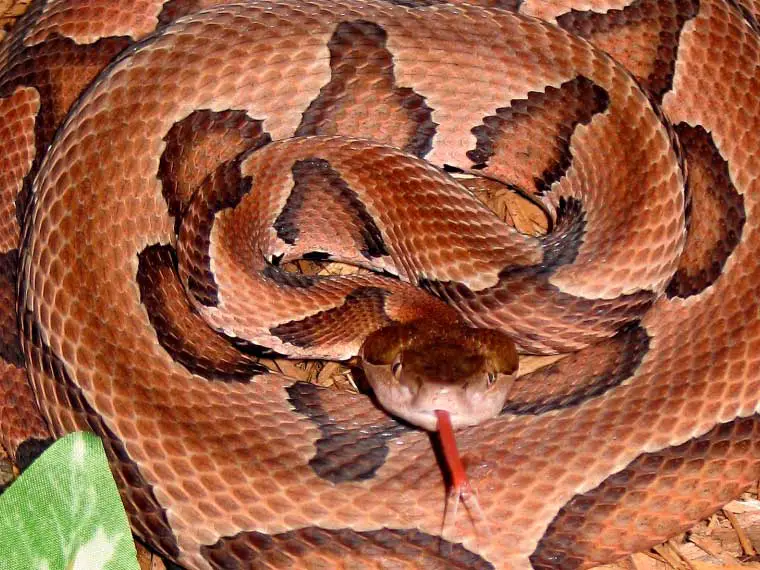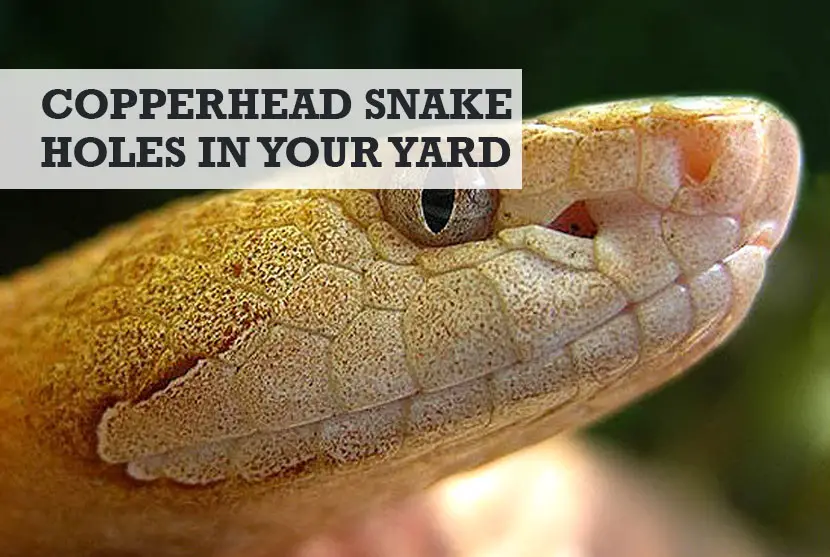Seeing a Copperhead snake in your yard is enough to induce anxiety in most people, particularly those with small children and pets. Whilst they are not aggressive snakes, they do have venom (which thankfully is rarely deadly).
You might not have seen one though, and instead could be seeing what you believe to be Copperhead snake holes in your yard. Copperheads do live in holes, but the holes in your backyard could be there for an entirely different reason.
Below I’ve outlined what Copperhead snake holes look like so you can identify whether you have them in your yard. It also includes other things to look out if you think this snake species has made your yard their home.
Hopefully what you think are Copperhead snake pit holes are something completely different and you can relax after reading this guide.
Handy Hint: You could try putting “Snake Out” (buy on Amazon) down the suspected Copperhead holes to flush them out. It won’t kill them but can make them leave your yard.
Do Copperheads live in holes?
Yes, Copperhead snakes do live in holes, but also other places such as in and under log piles, in soft vegetation, crawl spaces. Anywhere else that offers a warm and safe environment for them will also become a home for them.
They like to be near water and vegetation but won’t dig their own holes in your yard. Instead, Copperhead snakes will find holes created by other animals, typically those of rodents.
Copperhead snakes will then hibernate in the hole in your yard from Fall, coming back out in early April. They will often hibernate with other Copperheads, so there could be more than one in the pit or hole in your backyard.
The species is most common in Alabama, Arkansas, Georgia, Kentucky, Louisiana, Mississippi, Missouri, North Carolina, Tennessee, Texas, and West Virginia.
What do Copperhead snake holes look like?
As Copperhead snake holes tend to originally be holes dug and created by other creatures, there’s no real way of saying what a Copperhead snake hole look like. It could like any small and suitable backyard hole in truth.
For this reason, it’s quite hard to identify a Copperhead snake hole.
But bear in mind, Copperheads will like comfortable, safe, and warm holes so won’t use large holes dug out by larger mammals. They will prefer small and cosy holes perhaps no more than three inches in diameter.
Like most snakes, a Copperhead can burrow through vegetation and leaves, but they cannot dig down and deep into compacted earth, typical of that found in backyards.
And that’s why Copperhead snake holes will always start out belonging to another creature, rather than appearing suddenly overnight.
Critters that make Copperhead snake pit holes
Bear in mind that what you think are Copperhead snake holes in your yard could be from an entirely different critter altogether. But that doesn’t mean a Copperhead won’t be living in one, they might have taken it over.
The original holes in your yard could result from other animals as diverse as:
- Birds
- Chipmunks (here’s how they look different)
- Moles (compare mole holes to ones snakes live in)
- Rats or mice
- Skunks
- Squirrels (how to stop them)
The animals above will all make holes that can then be used as a Copperhead snake hole. Sometimes the size of the mound by the hole can be a giveaway.
Handy Hint: Here’s what holes in your yard but no mounds can mean.
How do you tell if a snake is in a hole?
The thought that there are Copperhead snakes in the holes in your yard might send a shiver up your spine. I don’t blame you, and for those with young children and small pets it’s legitimate concern.
Any Copperhead snake holes in your yard are likely an active habitat with a few clues. Obviously, the biggest clue is seeing a Copperhead snake in your backyard, here’s what one looks like.

Here’s a definition by the NewsObserver.com website:
“Copperhead snakes are brownish-gray in color with an hourglass-shaped pattern on their backs, which resembles a Hershey’s Kiss. Newly born or very young copperheads will resemble their parents, except they’ll have a bright yellow or greenish-tipped tail that darkens pretty quickly. Adult copperheads grow to about 3 feet long.”
If you’ve not seen one though, but just found what you think are Copperhead snake pit holes, other signs include:
- Newly shed snakeskin suggests snakes live in your yard’s holes.
- Snake feces near or outside the hole offer a sign of life.
- Spiderwebs over the hole will mean there’s no snake in there.
How to get Copperhead snakes out of your yard
If you want to know what repels Copperheads and how to get rid of them from your yard, here’s a list.
- Snake repellent (Snake Out on Amazon is excellent).
- Remove food sources – this can include using rodenticide.
- Remove hiding places and warmth.
- Cut your yard’s lawn and prune back bushes.
- Install a snake proof fence.
Snake Out does not kill Copperhead snakes but will annoy the reptile enough by disturbing its sense of smell, to hopefully make it want to relocate away from your backyard. You sprinkle it over your yard or put into spaces and holes where the snake has been.
I know some people who will even put the product down the Copperhead snake snake holes in their yard.
Handy Hint: I believe that (some) snakes are good for your yard, here’s why.
How to protect your yard from Copperhead snakes
Once you’ve got rid of the Copperheads, you need to take steps to ensure they don’t come back. That means assessing your backyard and how it’s all put together and what type of environment you’ve created that attracts the snakes in the first place.
Here’s what you need to remove or assess to protect your backyard from Copperhead snakes.
1. Don’t leave an environment for them to live and hide in
Snakes need warmth and hiding places so will thrive in backyards that have thick undergrowth such tall grass, bushes, wood piles, and random logs.
Is your yard in need of a mow? If it is, get that grass cut down to a tidy length of no more than a couple of centimeters, break up any wood piles, and take logs and hiding places out of your backyard
2. Take measures to rid your yard of rodents and bugs
Copperhead snakes also love yards that have a reliable and constant food source. If your backyard contains a healthy number of bugs, it will attract snakes. The same goes for rodents.
So, if you have a rat and mouse problem, you could also have a snake problem.
The same goes for frogs and toads. Copperheads love them, so could be attracted to a pond or water source in your backyard.
3. Think about your garden furniture arrangements
Snakes will love the shade and warmth that your garden furniture can provide.
Whilst it’s impossible to get rid of your furniture, regularly check under cushions and chairs, and move things daily so snakes can’t get comfortable in making a home in your backyard.
4. Block off crawl spaces
Snakes will love a crawl space under your house as it gives them a place to hide and check out any activity in your backyard. They can sleep in there and be protected, them come out onto the yard space when it’s time to hunt for critters.
Make regular checks of crawl spaces, or better still, see if you can completely block off any access routes for snakes… they can get into the smallest of gaps.
What do Copperheads eat?
If you’re aware of what this snake species eats, you can remove that food source from your backyard as a temptation.
Here’s what their diet consists of (from Texas.gov), and shows what might be getting taken down into the Copperhead snake pit holes in your yard
“Copperheads feed on baby cottontails, swamp rabbits, rats, mice, birds, snakes, lizards, baby turtles, frogs, toads, and insects, especially grasshoppers and cicadas.”
Conclusion
The sudden appearance of holes in your backyard will not be a Copperhead snake. They cannot dig their own holes, but instead inhabit those of other creatures.
If you see the signs of a Copperhead snake in your yard, they could have made the holes that already existed on your lawn their home for hibernation and warmth.
You might also like…
- Why you have so many dead bees in your backyard
- Are snakes bad for your yard?
- Why I don’t recommend putting things in snake holes
Copperhead snake in the header via https://en.wikipedia.org/wiki/Eastern_copperhead#/media/File:Kupferkopf-02.jpg


